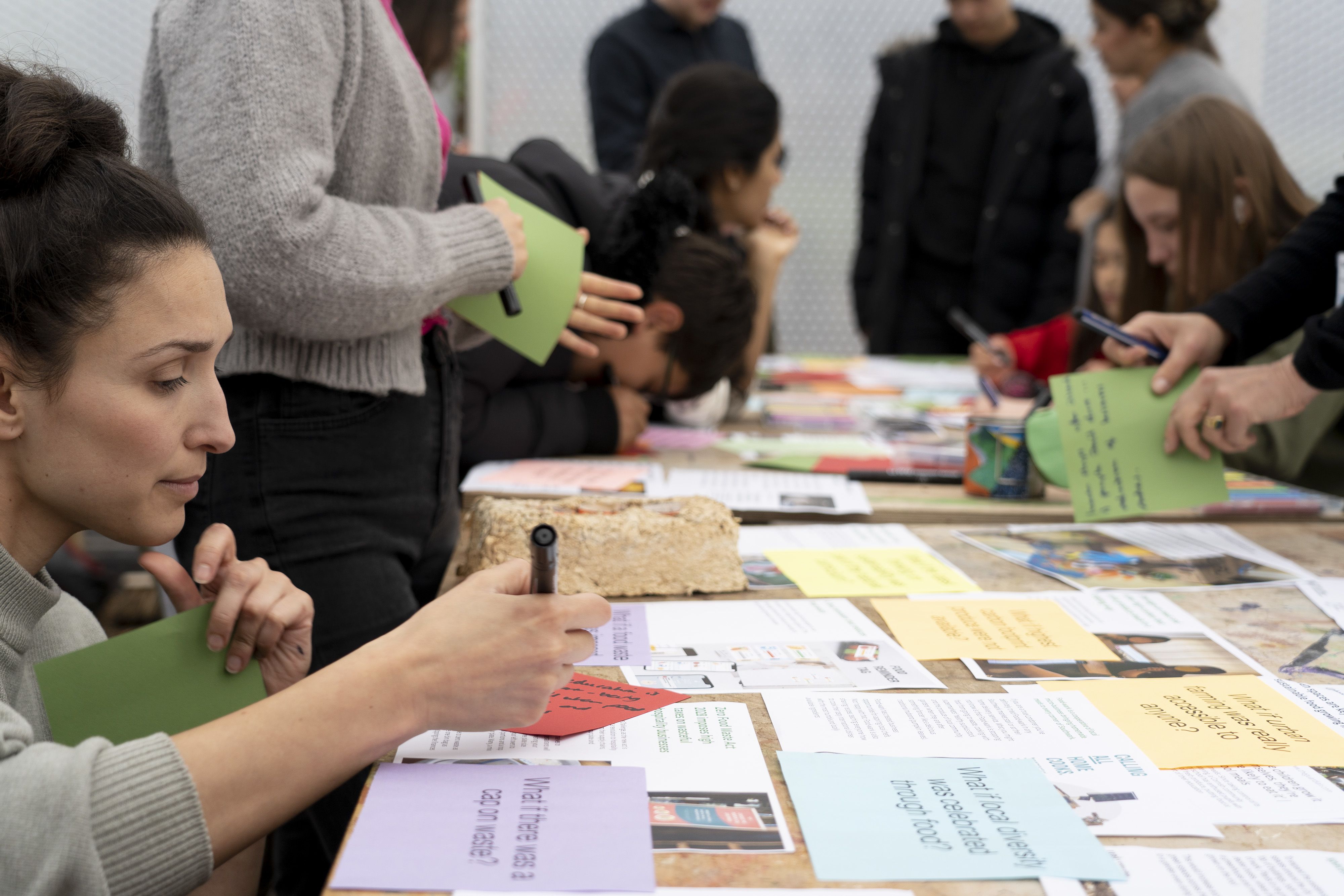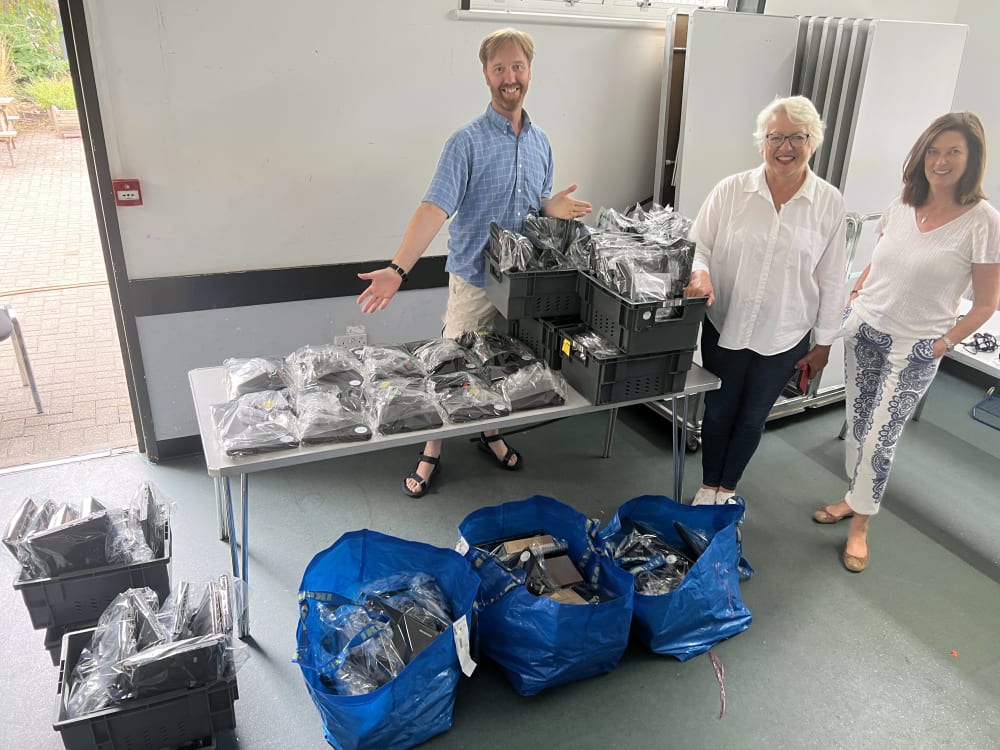
Future Observatory 2022: what we achieved through our Design Exchange Partnerships

- Written byAnnika Loebig
- Published date 25 November 2022

Since November 2021, the Arts and Humanity Research Council and Design Museum have been bringing together researchers, designers and industry stakeholders for Future Observatory: a national programme to harness design research to inform the UK’s response to the climate crisis, including decarbonisation, waste reduction and circular economies.
UAL was leading on 3 of the 15 UK-wide Design Exchange Partnerships funded by the initiative in 2021, including collaborations between
- Creative Computing Institute (CCI) and not-for-profit Power to Connect (P2C) to address digital waste and lack of access to online learning within deprived communities
- Service Futures Lab and Southwark Council to apply design thinking into policies that support food sustainability as part of a long-term strategy to help the borough achieve net zero by 2030
- Centre for Sustainable Fashion (CSF) and B-Corp certified social enterprise and luxury retailer Elvis & Kresse (E&K) to help the brand become a net regenerative business by 2030
Hear about their achievements and the potential long-term impact of their design partnerships:

Centre for Sustainable Fashion x Elvis & Kresse
Professor Sandy Black and Dr Mila Burcikova worked with Elvis & Kresse to help catalyse the company’s current transition from their commitment to net zero by 2030 to a more ambitious goal: being net regenerative by 2030. Part of this included an exploration of how they could embed the concept of ‘Fashion Making in a Dynamics of Place’ into the brand's operations.
The key outcome of the project is a ‘Regenerative Transition Pamphlet’, which captures the key period of Elvis & Kresse’s regenerative transition.
The pamphlet provides a basis that enables Elvis & Kresse to communicate their new ambitions and strategy in a manner that appeals to their customer base. It introduces key topics and milestones divided into 2 contextual and 5 thematic sub-sections with rich photo documentation:
- Doing the most important job
- Net zero and net regenerative: An introduction
- Headquarters and workshop
- Site set up and planting
- Soil
- Vineyard and other farm income
- Animals
The extensive visual documentation of E&K’s regenerative transition that the team collected between November 2021 and July 2022, consisting of nearly 2000 images, was also made available to the company for its communication, promotion and archive purposes.
“Without this project we would not have had the time or the ability to step back and observe the hugely complex transition we are undertaking. This gives us a unique and invaluable view which we will be able to use and share,” Kresse Wesling from Elvis & Kresse says.
“Given the climate and biodiversity crises we are facing, pioneering businesses like ours need to find ways to show how this can be done - the outcomes of this project are absolutely crucial as it will help us to share this transition more widely and transparently.”
The pamphlet offers a powerful case study of a regenerative transition that can be adapted, scaled up and scaled across by design-led fashion businesses in other UK regions and beyond.
By sharing E&K’s regenerative experiences, the project provides a groundwork for activating local and regional networks that draw on shared values and benefit from pre-competitive resource- and skills-sharing in regenerative practice.

Creative Computing Institute x Power to Connect
Through CCI’s partnership with Power to Connect, led by CCI’s Senior Lecturer Irtiza Nasar and Professor and Research Leader Mick Grierson, they were able to develop a data wiping solution to ensure that second-hand devices can be safely repurposed and handed over to young people.
They then developed an MVP of their data wiping tool to showcase the potential benefits of the system and the impact the software can have on reducing e-waste. They also provided Power to Connect with something they can immediately start using to increase their volunteer capacity and a number of incoming device donations.
“This project has been an exciting start to what has potential to be bigger more impactful collaboration with UAL’s Creative Computing Institute,” says Megan Barrett, Head of Operations at Power to Connect.
“The new system created has meant our volunteer recruitment process can be more flexible, and we can now recruit volunteers from all backgrounds not only from IT specialist backgrounds.”
“There are several strategic areas that the project aims to have an impact on with its research findings,” Irtiza tells us.
“As P2C only currently repurposes laptops, we hope the research findings can develop our technology further to wipe other devices for re-use, such as mobile phones and tablets, while also targeting more recent models of laptops and potentially other smart devices.”
“Furthermore, P2C currently have 65 volunteers and only one permanent staff member. They aim to double the number of trained volunteers by the end of the project hence the project aims to half the entry barrier and training time to use such software by simplifying the current processes.”
Additional aims also include supporting P2C’s distribution of more devices to around 300 schools to address the digital divide, as well as increasing the number of donor organisations using their software to repurpose and redistribute their devices.
Finally, the project partners hope that their documentation of the project’s impact will support their case to local authorities, councils, national education authorities and organisations to further support initiatives that address e-waste and digital equity in the future.
On 22 November, CCI was invited to share their project in a panel discussion for Imagination Lancaster at Lancaster University in partnership with Future Observatory.
Find out more about CCI’s Design Exchange Partnership with Power to Connect.

Service Futures Lab x Southwark Council
As part of a longer-term partnership to help Southwark Council reach net zero by 2030, LCC’s Service Futures Lab, led by Dr Lara Salinas, worked with the council’s Climate Emergency Team to employ design thinking into policies that support food sustainability.
“One of the reasons we chose to focus on food sustainability is because we understood that the topic was timely; it was a very strong priority, and there are lots of things to do to make a positive impact,” Lara Salinas explains.
“Our purpose was to explore together with the local government that there are different ways of doing policy and services with people. Food was a very democratising topic; everyone can relate to it.”
Initially, the project was supposed to facilitate a round of engagement activities with students involving children and people on the street to create preferable futures through a critical service design methodology.
The group would then report their findings back to the local authority to inform decision-making on the topic of sustainable food.
“What happened was that we were awarded additional funding to run Climate Studio: an urban network of citizens, organisations and government to support collaborative place-based climate action.”
“Thanks to this round of funding, we were able to engage with 4 different local organisations trying to create a stronger network to do climate action. During this, we engaged 100 residents, all of which were children and young adults.”
The partnership went on to influence Southwark’s Sustainable Food Action Plan and facilitated a workshop at a service design and government conference, during which members from the local government joined the group to engage 33 service designers working internally and externally with local government. Lara also published a paper on designing for local policy based on the project’s developments.
“We’ve had local authorities reach out to us, because we're building a very strong expertise on how local governments deal with the climate emergency. Because of the scale of the project, we learned a lot about how to engage local communities, and what the fair and ethical terms of engagement are when reaching out.”
“This is about asking: how can we join forces and give each other more resources to do the right thing?”
Find out more about Service Futures Lab’s partnership with Southwark Council and the Climate Studio.
Hear from Dr Lara Salinas about working with Southwark Council to embed design in local governance and her conversation with the BBC Radio 3 about how local communities can play a role in cutting carbon emissions.